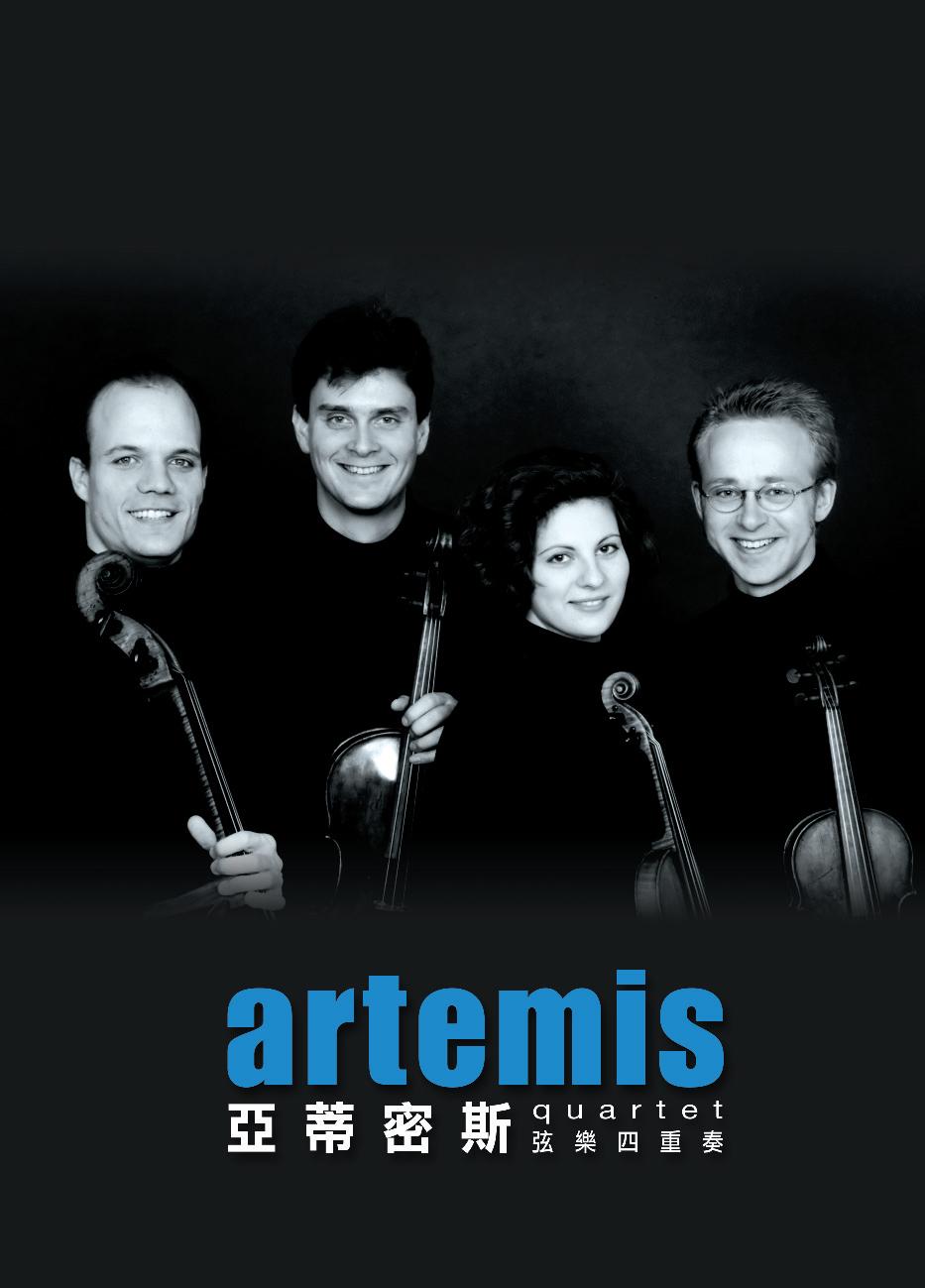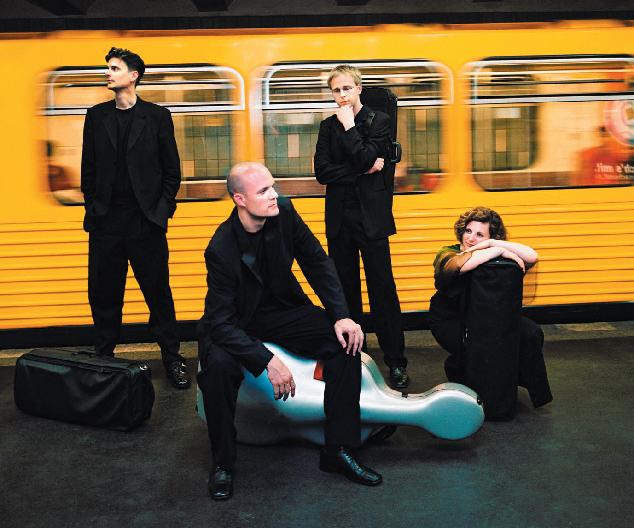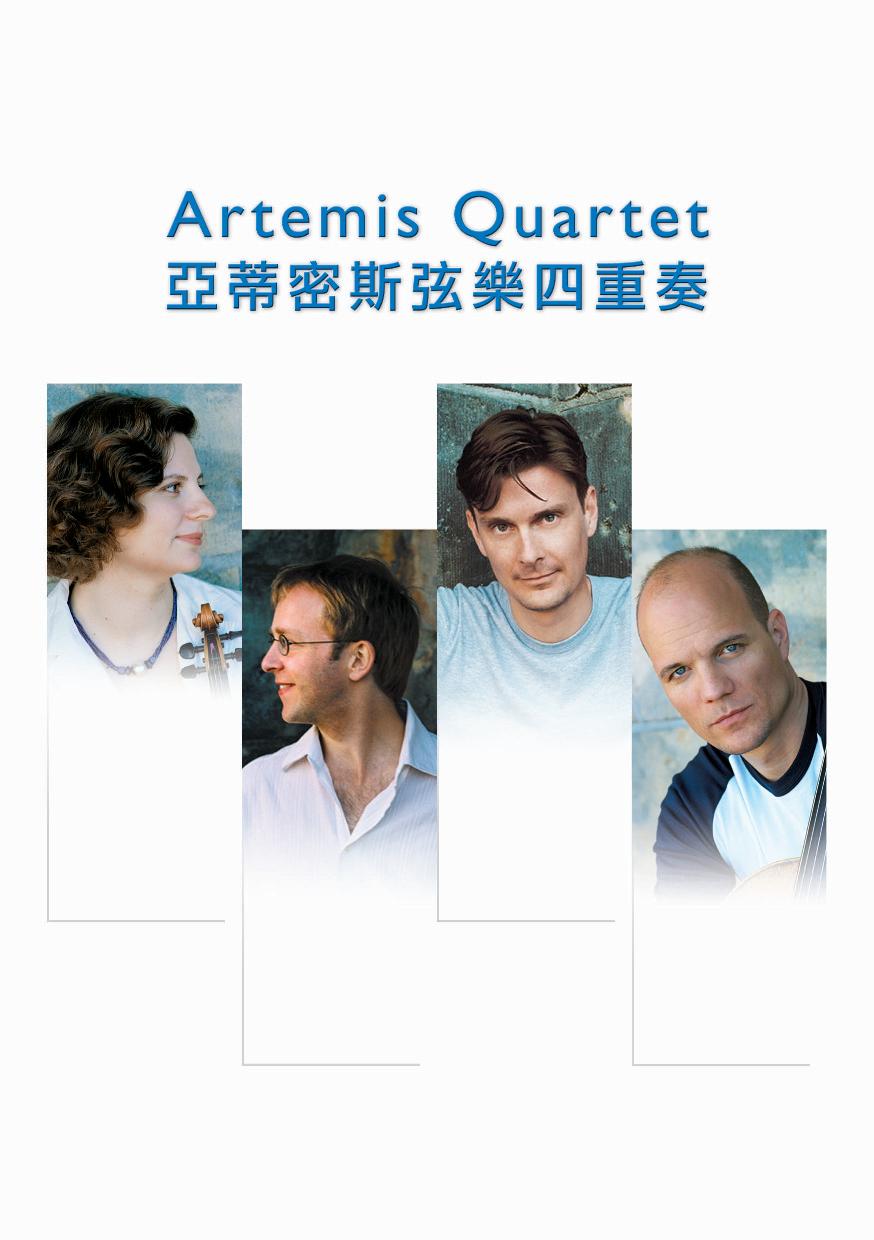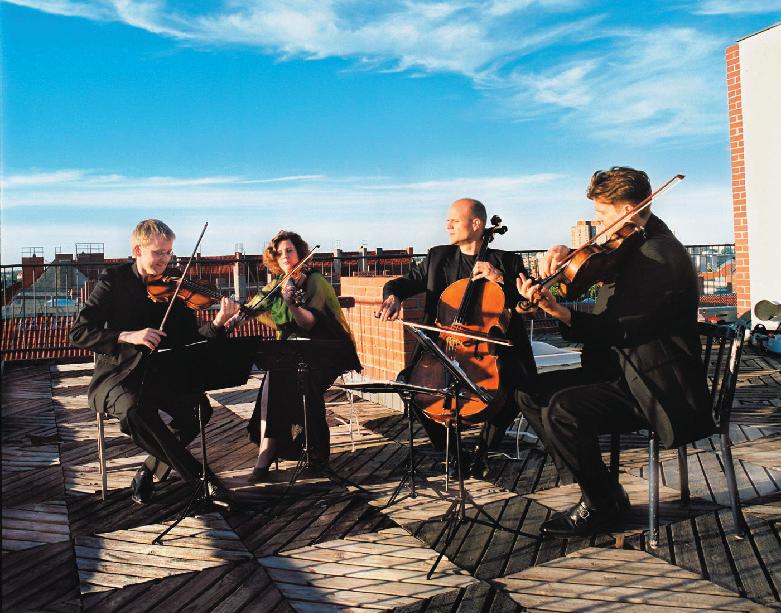

Artemis Quartet
亞蒂密斯 弦樂四重奏

四重奏成員 Quartet Members
四重奏介紹 Quartet Profile 曲目
所有照片
香港大會堂音樂廳
Concert Hall
Hong Kong City Hall
節目長約3小時, 包括兩節20分鐘中場休息
Running time: approximately 3 hours with two 20 minute intervals
為了讓大家對這次演出留下美好印 象,請切記在節目開始前關掉手錶、 無㵟電話及傳呼機的響鬧裝置。會場 內請勿擅自攝影、錄音或錄影,亦不 可飲食和吸煙,多謝合作。
To make this performance a pleasant experience for the artists and other members of the audience, PLEASE switch off your alarm watches, MOBILE PHONES and PAGERS. Eating and drinking, unauthorised photography and audio or video recording are forbidden in the auditorium. Thank you for your cooperation.
娜塔莉亞.佩斯切帕科
Natalia Prishepenko
小提琴 Violin

埃米.梅勒
Heime Müller
小提琴 Violin
沃克.雅各布森
Volker Jacobsen
中提琴 Viola
埃克特.朗格 Eckart Runge
大提琴 Cello

亞蒂密斯弦樂四重奏 Artemis
以柏林為基地的亞蒂密斯弦樂四重 奏, 1989 年於德國呂貝克音樂學院成 立, 1994 年起成員未有更動。樂團受 教於多位良師與前輩,包括華特.列 文、愛默生四重奏、茱莉亞四重奏和 伯格四重奏,並曾獲世界知名的德國 第一電視台國際音樂大賽大獎,以及 令樂團聲名鵲起的意大利博西安尼國 際弦樂四重奏大獎;時至今日,亞蒂 密斯弦樂四重奏已成為最優秀的合奏 團之一。
樂團成員並未故步自封,開展了一段
特訓時期,以進一步磨練音樂造詣,
更於 1998 年往維也納進行為期一年的
密集鍛鍊; 1999 年四位樂手應邀在柏
Quartet
The Berlin-based Artemis Quartet was formed in 1989 at the Conservatory of Music, Lübeck, Germany, and has been performing with its current line-up since 1994. Their influential teachers and mentors were Walter Levin, the Emerson Quartet, the Juilliard Quartet and the Alban Berg Quartet. They received top awards in the German ARD Music Competition and in the prestigious ‘Premio Borciani’, which heralded the Quartet’s international breakthrough. Today the Artemis Quartet is already one of the top ensembles of its kind.
Eschewing what looked to be the makings of an immediate and meteoric career for the time being, the members of the Artemis Quartet embarked on a period of intensive work to further hone their musicianship, and in 1998 the ensemble moved to Vienna for a year of intensive study. In 1999 the four musicians accepted
林科學院留駐三個月,同年6 月他們與 柏林愛樂樂團的首度演出,成為他們 再次活躍於演奏台的里程碑。
多年來,樂團曾為科隆的西德廣播電 台籌劃音樂會系列; 2004 年則為柏林 愛樂音樂廳舉行樂團的演奏會系列; 從2003 到2005 年,亞蒂密斯弦樂四重 奏是英國廣播公司第三台「新一代藝術 家計劃」的一份子,在英國多個城市演 出及錄音。除了在世界各大表演場地 舉行音樂會及參與各地的國際音樂 節,樂團還致力於教學,自 2005 年 起,四位樂手兼任柏林藝術大學室樂 訪問教授,同時輪流出任布魯塞爾的 伊麗莎伯女王音樂學院的訪問教授。
亞蒂密斯弦樂四重奏一直非常着重與 其他音樂家的合作,經常同台演出的 音樂家包括莎比娜.邁亞、依麗莎 伯.列翁絲卡雅、戴維.葛寧格斯、
尤莉安娜.班絲及利夫 - 奧維.安斯 斯。另一方面,他們對新音樂的興 趣及與當代作曲家的密切交流,也深 深影響了樂團發展。在 2004/05 年度 的樂季,他們便首演了蘇堤羅和衛德 曼的新作。
亞蒂密斯弦樂四重奏屢獲殊榮。在 2001 年,樂團奪得著名的德國樂評人 協會音樂大獎,成為首個奪得此獎項 的四重奏。
他們灌錄的貝多芬作品 59/3 和作品 132 ,得到 2000 年的德國唱片樂評特 別獎;而在 2002 年,他們憑貝多芬和 利格堤的錄音,兩度獲法國的金音叉 獎; 2003 年,波恩的貝多芬故居協會 頒授榮譽會員資格予亞蒂密斯弦樂四 重奏,以表揚他們在演繹貝多芬作品 上的成績; 2004 年,他們獲頒意大利 西耶納的第 23 屆奇吉阿那音樂學院國 際大獎。
亞蒂密斯弦樂四重奏於 2005 年與 Virgin Classic/EMI 唱片公司簽約,計 劃在五年內推出最少 10 張專輯。
an invitation for a three-month residency at the Berlin Science Academy. Their debut performance with the Berlin Philharmonic Orchestra in June 1999 marked the energetic resumption of their concert activity.
For a number of years, the ensemble programmed a concert series for the radio station WDR Cologne, and this was followed in the year 2004 with the Quartet’s own series for the Berlin Philharmonie. From 2003 until 2005, the Artemis Quartet was part of the ‘New Generation Artists Scheme’ programme of BBC Radio 3, with concerts and recordings in a number of cities in the UK. In addition to a busy concert schedule taking in all the major music centres as well as performances at international music festivals around the world, the Artemis Quartet is also committed to teaching. Since the summer semester of 2005, the four musicians have been Visiting Professors for Chamber Music at the University of the Arts in Berlin, and they also take turns teaching as part of a Visiting Professorship at the ‘Reine Elisabeth’ Conservatory in Brussels.
From its very inception, the Artemis Quartet has always assigned a high priority to performing with other musicians: Sabine Meyer, Elisabeth Leonskaja, David Geringas, Juliane Banse and Leif Ove Andsnes are just some of their regular partners. Another important influence on the Quartet’s development has been their curiosity for new music, and their engagement with contemporary composers. During the 2004/05 season alone, they performed two world premieres of compositions of Mauricio Sotelos and Jörg Widmann.
The Artemis Quartet has been the recipients of numerous awards. They were the first ever quartet to be awarded the prestigious Music Award of the Association of German Critics in 2001.
The Quartet’s CD recording of Beethoven’s Op 59/3 and Op 132 won the Special Prize of the German Recording Critics in 2000, and in 2002 they were twice awarded the Diapason d’Or (Beethoven / Ligeti). In 2003, the Association of the Beethoven House in Bonn granted the Artemis Quartet honorary membership for services in the interpretation of the works of Beethoven. In 2004, the Quartet was awarded the 23rd ‘Premio Internazionale Accademia Musicale Chigiana’ in Siena.
In 2005, the Artemis Quartet signed an exclusive contract with Virgin Classics / EMI, which provides for at least 10 new releases within a period of five years.
韋伯恩 (1883-1945)
弦樂四重奏, 1905
布拉姆斯 (1833-1897)
C小調弦樂四重奏,作品 51 ,第 1 首
快板
浪漫曲:稍慢板 中庸及舒適的稍快板 快板
-中場休息-
韋伯恩
五首弦樂四重奏樂章,作品 5
激烈地
甚慢
甚有活力
甚慢
溫柔地
布拉姆斯
A小調弦樂四重奏,作品 51 ,第 2 首 不太快的快板
中庸的行板 仿小步舞曲,中板 終曲:不太快的快板
-中場休息-
韋伯恩
六首弦樂四重奏小品,作品 9
中板
稍活潑的 流動的
甚慢
極慢 流動的
布拉姆斯 降B大調第三弦樂四重奏,作品 67 極快板
行板
激動地(不太快的小快板) 變奏和小快板
Anton Webern (1883-1945)
String Quartet, 1905
Johannes Brahms (1833-1897)
String Quartet in C minor, Op 51, No 1
Allegro
Romanze: Poco adagio
Allegretto molto moderato e comodo
Allegro
– interval –
Anton Webern
Five Movements for String Quartet, Op 5
Heftig bewegt
Sehr langsam
Sehr bewegt
Sehr langsam
In zarter Bewegung
Johannes Brahms
String Quartet in A minor, Op 51, No 2
Allegro non troppo
Andante moderato
Quasi minuetto, moderato
Finale: Allegro non assai
– interval –
Anton Webern
Six Bagatelles for String Quartet, Op 9
Mässig
Leicht bewegt
Ziemlich fliessend
Sehr langsam
Äusserst langsam
Fliessend
Johannes Brahms
String Quartet No 3 in B flat major, Op 67
Vivace
Andante
Agitato (Allegretto non troppo)
Poco allegretto con Variazioni
韋伯恩
弦樂四重奏, 1905
就像一群雄馬使勁脫離韁繩的駕馭,這首 韋伯恩的早期作品義無反顧地擺脫十九世 紀的和音與主題;在澎湃的生命力之中, 樂曲顯出不平凡的美。
雖然這首最近才被發現的四重奏是韋伯恩 學生時期的作品,但他是荀伯克的得意門 生,並且專研中世紀音樂技巧;在往後的 30 年,他發展出自己一套極之複雜的音 樂。
韋伯恩生於奧地利一個小村落, 22 歲在維 也納讀書時,正身處個人音樂風格的過渡 期,在濃厚浪漫的馬勒、史特勞斯和早期 荀伯克之間,韋伯恩培養出獨特才華,不 久更成為一位受人尊崇的指揮家。直到 1930 年代末,韋伯恩的事業發展相當不 俗,但在第二次世界大戰期間,因為他的 音樂並不合納粹政權的口味,被迫過着隱 居生活。戰爭過後的一個晚上,他出外吸 煙,卻誤被一名美軍開槍擊斃,可謂天意 弄人。
韋伯恩的作品經常參照詩人歌德的意念, 這首四重奏也不例外,表達了歌德所描述 的有機創造:「根、莖、葉、花,全都是一 個意念的不同演繹。」
在音樂方面,這首 15 分鐘的作品由升 C 、 C 和 E 三個音符小單元演化而成,就像十六世 紀的音樂,曲子不斷開展,卻沒有甚麼結 構;此曲也是一個圖像作品,很明顯的分 為三個看得見的部份,而韋伯恩參考的是 一位瑞士藝術家塞岡蒂尼描畫人生的一套 三件畫作,作品名稱為《生命》、《自然》和 《死亡》。在背景况,我們可以「聽」到韋伯 恩深愛的、覆蓋着白雪的阿爾卑斯山。
Anton Webern String Quartet, 1905
Like a herd of stallions straining headlong against their reins in every direction, this early piece by Anton Webern strains to pull away from 19th century harmonies and themes. In the feverish activity, the piece has an uncommon beauty.
Yes, this recently discovered quartet was a student work, but Webern was a student of Arnold Schönberg — and a scholar of medieval musical techniques. So, over the next three decades he evolved with his extremely complex music.
At 22, coming out of a small Austrian village, educated in Vienna and soon to become an esteemed conductor, Webern was in between the sweet excesses of Mahler, Strauss and early Schönberg and his own genius-to-be. While busy enough before the late 1930s, he was forced into a rather monastic life during World War II, (his music hardly suited to the Nazi regime). Ironically, after the war he was out at midnight for a cigarette and was shot by a nervous American soldier.
Like all his work, this quartet reflects Webern’s frequent references from the poet Goethe, describing an organic creation: “The root, the stalk, the leaf, the flowers, all are variations of the same idea”.
Musically, the 15-minute piece comes out of a three note cell, C sharp, C and E, and like 16th century music, it ‘continues’ rather than having a real structure. But this is also a pictorial work easily divided into three visual sections. Webern based the piece on a trio of paintings by a Swiss artist Giovanni Segantini, depicting the passing of human seasons entitled Life , Nature and Death . In the background, one can ‘hear’ the snow-clad Alpine mountains which Webern loved so deeply.
作品 51 ,第 1 首
布拉姆斯不喜歡別人拿他跟貝多芬比較,
所以他遲至四十多歲,才發表第一首四重 奏,作品經過 20 年的琢磨。他對朋友說: 「你不會理解那種感受,就像經常聽到他的
腳步聲在我後面一樣。」布拉姆斯從來就不 謙虛!
貝多芬不只是他心理上的勁敵,更深入他 作品的織體。首樂章和終樂章都帶着貝多 芬式的激情,迷人的第三樂章中段,簡直 就是抄襲貝多芬一首後期的四重奏作品, 寬容的聽眾大可視之為對作曲家的致敬。
樂曲透着貝多芬的風格:充滿動力的英雄 式序幕震撼人心,然後第一小提琴奏出陰 沉的對位,接着是兩個小提琴帶出抒情的 第二主題,中提琴則奏着跳躍的音形;所 有的素材都得到發展,樂章以激動的終曲 而結。
一如傳統,第二樂章就像一首無言之歌, 兩個主題帶着渴望的對比,再現時次序互 調。
最令人玩味的是第三樂章,簡樸的間奏曲 引領樂曲到較快的樂段,色彩獨特;第二 小提琴在兩根弦上奏出相同的音(稱為「色 彩奏法」),帶出意想不到的爵士效果。
終曲的展開用了原來的英雄主題,接着是 第二主題和較輕鬆的第三主題,布拉姆斯 還來不及加以發展,這些主題便隨着舒展 的、充滿動感的終曲重現,結束了樂曲。
Johannes Brahms String Quartet in C minor Op 51, No 1
Brahms waited until his 40s, working and revising for 20 years before publishing his first quartet, mainly because he hated being compared to Beethoven. “You don’t know what it’s like” he said to a friend, “hearing his footsteps constantly behind me.” (Modesty was rarely in Brahms’ nature!)
Beethoven was not only the psychological nemesis, but made his way into the very texture of the work. Outer movements have Beethovenian vehemence and the charming third movement has a middle section with virtually a plagiarism from a late Beethoven quartet, though one should charitably prefer to call it a homage to the composer.
Those references are almost inevitable after being stunned by the dynamic heroic opening, followed with a more languid counterpart in the first violin, a lyrical second theme played by the two violins and a leaping figure in the viola. Brahms develops all of this music, brings it back again and ends with an exciting, even agitated coda.
As was traditional, the second movement is a kind of song without words, differentiated with a more wistful contrast, and then both themes return in reverse order.
Most interesting of all is the third movement, a simple intermezzo leading to a faster section with a most unusual piece of colour. The second violin plays the same note on two different strings (called a bariolage), giving an unlikely jazz effect.
-中場休息-
The finale’s opening comes from the original heroic theme, followed by a second and relatively relaxed third theme. Brahms barely has time to develop them before they reappear with an extended dynamic coda. – interval –
韋伯恩
五首弦樂四重奏樂章,作品 5
韋伯恩曾說:「我覺得最吸引的,是深山幽 壑,當中藏着蒼松和一些未為人知的草
木,它引人入勝之處並不在景色之美,我 所尋找的是萬物中那深邃、無邊無盡的真 諦。」
這個對「美」和「真諦」的分野能否讓我們更 了解成熟時期的韋伯恩?他把自己從十九 世紀的和音、節奏和結構中解放出來,他 對事物相互關係的觸覺有如數學家般敏 銳,但一如所料,他要尋找的東西卻是鏡 花水月。
或者他認為音樂已偏離它的數學源頭太 遠,而數學則偏離了其哲學根源;若果是 這樣,我們就要把這些精練的樂章視為哲 學的音樂宣言,或是︙︙音樂的真諦。
樂曲寫於 1909 年,雖然樂曲有革命性的聲 響效果,但仍然可以稱為一首傳統的弦樂 四重奏。第一樂章是奏鳴曲式,開奏的兩 個輕快音符成為第一主題,然後,大提琴 的三擊後引出第二主題,音樂的發展部複 雜微妙,兩個主題再現的時候,小提琴 取代大提琴的角色,而開奏的兩個音 則倒轉。
第二樂章有一個由各聲部分奏的主題,第 三樂章只長 40 秒,由四個音符的小提琴主 題發揮;緊接的樂章開始時是兩個耐人尋 味的和弦,承接的四音音階,演變出其他 素材。
終樂章帶着神秘感,旋律幅度廣闊,幾個 音符帶出了細語和弦及旋律片段,若你細 心聆聽,便可聽到一些零散的第四樂章素 材,然後音樂靜靜淡出,歸化於韋伯恩的 宇宙。
Anton Webern Five Movements for String Quartet, Op 5
“Deep valleys with mountain pines and mysterious plants have the greatest appeal for me,” wrote Webern. “But not because they are ‘beautiful’ do they move me. My object is the deep, bottomless inexhaustible meaning in all of nature.”
Could this differentiation between ‘beauty’ and ‘meaning’ explain the mature Webern? He had emancipated himself from ordinary 19th century harmonies, rhythms and structure, he had an innate mathematician’s sense of relationships, but preeminently, he was searching for what can never be found.
Perhaps he felt that music had strayed too far from its mathematical roots, and mathematics had strayed from its philosophical roots. In that case, one must look at these abbreviated movements as musical statements of philosophy, or....yes, the ‘meaning’ of music.
Despite their revolutionary sounds, Five Movements, written in 1909, can still be called a traditional string quartet. The first movement is actually in sonata form. The first two jaunty notes become the first theme. Then, with three strokes of the cello comes a cello second subject. The development is complex, but both themes return, with the violin replacing the cello, the first two notes turned upside-down!
The second movement has one theme divided among the soloists, and the third movement — about 40 seconds long — is based on a four-note violin theme. The next begins with two mysterious chords, followed by a four-note scale from which the other material comes.
The finale is really mysterious. A few notes of a wideranging melody introduces whispered chords and melodic fragments. Listen carefully and you hear bits of the preceding movements, and then the music quietly fades away into the Webernian cosmos....
布拉姆斯
A 小調弦樂四重奏
作品 51 ,第 2 首
就像之前的一首弦樂四重奏(卻有別於今晚
的最後一首),布拉姆斯在這首曲子下了 20 年的苦功,由 1850 年代他還年輕的時候開 始寫,直到 40 歲,而這次隱伏在背景的作 曲家是巴赫。運用一個巴羅克作曲家的技 巧稱不上是時興之舉,但憑着堅實的音樂 功力,布拉姆斯在對位(尤其是卡農部份, 就像韋伯恩的弦樂四重奏)和其他複音音樂 上都發揮得很自然。
此作品亦暗藏玄機。首位演奏此曲的小提 琴家姚阿幸的格言是:「自由,但寂寞」, 在德文况,句中每個字的起首字母分別為 F 、A 、E ,也是樂曲開奏的第二、三和四個 音符,而第一個是 A ;然後,布拉姆斯用了 他自己較積極的格言:「自由,但快樂」, 把起首字母F 、A、F 化成音符,融入作品的 織體。
不過,第一樂章優美之處並不在於這些玄 機。第一樂章不但充滿創意,布拉姆斯更 利用巴羅克的曲式,把自己和他最欣賞的 小提琴家的音樂動機糅進曲中。
第二樂章開始時是一段柔美的小提琴旋 律,以歌劇風格伸延,換調後再奏。第三
樂章的對位複雜至極,有卡農、雙卡農, 及以古體小步舞曲為基調的變奏。
終曲結合了匈牙利舞曲、圓舞曲和十八世 紀的卡農,燦爛地完成樂曲。
Johannes Brahms String Quartet in A minor Op 51, No 2
Like his earlier quartet (and unlike the final one tonight), Brahms worked tirelessly for over two decades on this piece, from his youth in the 1850s until he was 40 years old. The composer lurking in the background here was Johann Sebastian Bach. And while using the techniques of a Baroque composer was hardly the most modish thing to do, Brahms was so well schooled that the counterpoint (especially the canons, like the Webern quartet) and the other polyphony sound natural.
The work contains some secrets too. The first violin player of this work, Josef Joachim, had as his motto ‘Frei, aber einsam’ (Free, but lonely). The initials FA-E are quoted in the second, third and fourth notes of the opening (after the first note, A). Brahms then took as his motto the less daunting, ‘Frei, aber froh’ (Free, but glad). So then he wove the F-A-F notes into the whole texture of the quartet.
But these inside references are hardly necessary to appreciate the first movement. Not only is it constantly inventive, but Brahms used Baroque musical forms, even blending together the two motives of himself and his favourite violinist.
The second movement begins with a sinuous violin melody, which is expanded virtually in an operatic style, before returning in another key altogether. The third movement shows Brahms’ counterpoint at its most complex, with canons, double canons and variations on the original archaic minuet.
The finale is a combination of a Hungarian dance, waltz and 18th century canon, ending brilliantly.
-中場休息-
– interval –
韋伯恩
六首弦樂四重奏小品,作品 9 Anton Webern Six Bagatelles for String Quartet, Op 9
「小品」原意是指簡短而不矯情的作品,韋 伯恩的確做到「簡短」 整首六段共 57 個
音節,演奏時間僅約三分鐘,但樂曲卻遠 非不值一提之作。樂曲的每一音節,每一 音符,都蘊含樂譜的方向及跟其他音符與
和聲的關係,凝煉之處叫人嘆為觀止,就 如荀伯克所說:「相信有些東西只能以音樂 表達的人,自會理解這樂曲。」
韋伯恩說過,他所有音樂作品都受他母親 的死所影響,但他其實有自己的創作方 向。他教導學生「深入聆聽」,而以這首作 品而言,他應該加上:「快速聆聽」。
不過,聆聽這些作品還有兩種方法,第 一,留心細聽,你可以聽到一些重複的關
係,在開奏的時候,中提琴和大提琴相距 半音(D 和降 E),這個關係維持到樂曲末段 (G 和升 G)。
第二,你亦可在第三樂章找到一個維也納 圓舞曲的意念,雖然這只是一個聽覺的幻 像:兩拍的節拍被小提琴分成三拍,被中 提琴分成五拍。
最後一個,也是最好的方法,就是直接地 把每一個樂章想像為一隻手的動作、一塊 寶石的一面,或一句詩,就如韋伯恩自己 說:「不是聲音自己,而是萬物之道。」
Bagatelle means a short unpretentious work, and while Webern made these short — the whole six sections contain 57 measures and take only three minutes to play — they are hardly insignificant. Each measure, each note, contain directions on the score, relations with other notes and harmonies which would make a quantum physicist breathless. As Arnold Schönberg noted: “They are understood by those who believe that music can say things that can only be expressed by music”.
Webern himself said that all of his music was related to the death of his mother, but Webern’s own directions are more apt. “Listen profoundly,” he would advise his students. And for these works, he should have added “listen quickly”.
But there are two other ways to hear these works. Listening very carefully, you can hear certain recurring relationships. At the very beginning, the viola and cello play a half note away from each other (D and E flat), and this continues until the end (a G against G sharp).
You might even find a Viennese waltz notion in the third movement (though actually, this is an aural illusion: the two beat metre is divided into three beats by the violin and five beats by the viola).
The third way is the best. Simply listen to each movement like the movement of a hand, a section of a diamond or a line of poetry. As Webern himself said, “Not sounds themselves, but the laws of nature”.
布拉姆斯
降 B 大調第三弦樂四重奏,作品 67
這首布拉姆斯最後的弦樂四重奏,充滿陽 光氣息、調子輕鬆愉快,放在這樣嚴肅的 音樂會末段,效果就像這個豪華的亞蒂密 斯弦樂四重奏饗宴的香檳祝酒。
為甚麼此曲寫得那麼動人?首先,布拉姆 斯當時住在很好的房子,他把他的舒適愜 意都寫了出來;第二,他正在創作非常嚴 肅的第一交響樂,須要休息一下;第三,
布拉姆斯一直都喜愛海頓,海頓的影響滲 透這個作品的每個樂章。
布拉姆斯雖稱這個作品為「小玩意」,但 他顯然很喜歡每一個音節,由第一樂章的 移位重音和交互的節奏,到終曲那色彩和 變奏。
〈極快板〉開始時,有如號角吹奏獵歌 (重音都放在不對的音符上!),第二主 題同樣輕佻,經過較為沉靜的中段,過渡 部份用了混合的拍子,二四拍和六八拍互 相重疊。
第二樂章較為平和,除了中段稍微激憤,
小提琴主題是純海頓風格,又可視為維也 納風格,韋伯恩喜歡的歌曲;第三樂章是 「激動地」,但布拉姆斯說:「這是我所 寫過最溫柔的」,請細聽加了弱音器的小 提琴和大提琴,和沒有弱音器的中提琴所 拼出的音響色彩。
終樂章跳躍的主題有八個變奏,每一個突 出不同的樂器,在第七個變奏,布拉姆斯 加入一個海頓式的驚喜,用了第一樂章的 號角,引領到奔放的結尾。
樂曲介紹:哈里.羅爾尼克 場刊中譯:黃家慧
Johannes Brahms String Quartet No 3 in B flat major, Op 67
After such a serious concert, this sunny, lighthearted piece, the last of Brahms’ quartets, comes as a champagne toast for a sumptuous (if filling) Artemis Quartet banquet.
Why did he write so engagingly? First, he was in a lovely house and wrote how comfortable he was. Second, he needed a respite from composing his very serious first symphony. Third, Brahms always loved Haydn, and Haydn seems to influence almost every movement.
He called it “a trifle”, but Brahms obviously loved every measure, from the misplaced accents and cross rhythms of the opening to the colour and variations of the finale.
The Vivace opens with a hunting horn call (with accents on the wrong notes!), continuing with an equally frivolous second theme. Then, after a hushed interlude, the transition with mixed metres (technically, 2/4 against 6/8), land on top of each other.
The second movement is more serene (with a fairly angry middle), but the violin theme is pure Haydn (or Viennese, the kind of song which Webern loved). The third movement is labelled ‘agitated’, but Brahms called it “the most tender I have ever written”. Listen to the colour of the muted violins and cello playing against the un-muted viola.
The scampering theme of the last movement has eight variations, each headlining different instruments. Then in Variation 7, Brahms adds a Haydenesque surprise, using that original horn-call of the first movement, leading a fiery ending.
Programme Notes by Harry Rolnick
